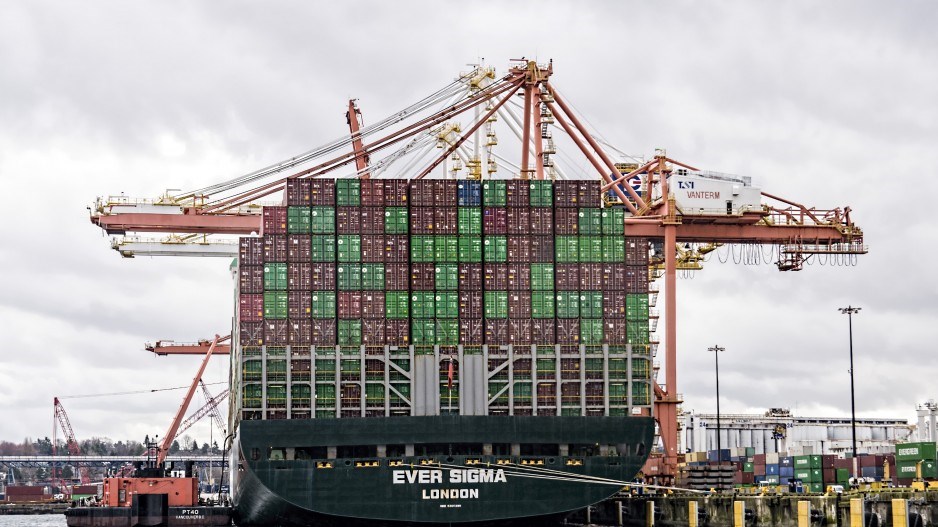On the list of complications the Port of Vancouver and the rest of the Asia-Pacific Gateway do not need in 2023, a labour disruption is near the top.
On second thought, make that right at the top.
Word this week that the 7,400 unionized dockworkers and foremen employed at Canada’s West Coast ports voted almost unanimously in favour of strike action to back their demands in 2023 contract negotiations with the BC Maritime Employers Association (BCMEA) moves the potential for that labour disruption closer to reality.
Any disruption to a transpacific supply chain that has only just begun to recover from almost three years of wild swings in cargo flow and historic port congestion caused largely by the COVID-19 pandemic would be bad news for every link in that chain.
It would also be bad news for anyone who works in that supply chain and benefits from the many highly paid jobs it supports.
The economies of Metro Vancouver, B.C. and the rest of Canada would likewise be hard hit by a port labour dispute.
As Bridgitte Anderson, president and CEO of the Greater Vancouver Board of Trade, has pointed out: “Supply chain stability is critical to Canada’s reputation as a reliable trading partner.”
That reputation is hard won and easily lost – especially in the relentlessly competitive maritime cargo shipping sector.
Unfortunately for B.C.’s ports and terminals, their reliability will already have been compromised by the International Longshore & Warehouse Union Canada (ILWU) strike vote.
Coupled with the stalled contract negotiations between port employers and the ILWU servicing West Coast ports in the United States, it will accelerate the migration of container and other transpacific port traffic to competing ports in Mexico and along the Gulf of Mexico and North America’s East Coast.
That migration had already been on the rise because of pandemic economy cargo congestion at major West Coast North American container hubs such as Los Angeles-Long Beach.
As U.S.-based container shipping analyst John McCown points out in his latest update on North American port traffic, inbound volume at the 10 largest U.S. ports dropped close to 21 per cent in April compared with April 2022, which he said was “the third worst year-over-year decline in memory” and the seventh straight month of year-over-year double-digit decreases.
West Coast ports continue to suffer the largest declines in container traffic inflow.
McCown’s numbers at the end of 2022 showed December’s inbound volume to those ports down 19 per cent compared with the same month in 2021. It was also the fifth straight month of double-digit declines for West Coast ports.
Congestion and reliability issues have played a part in that inbound cargo decrease up and down the West Coast. The Port of Vancouver’s pandemic economy congestion woes were exacerbated by floods and wildfires in 2021 that knocked out rail lines and other transportation arteries for weeks.
It has struggled ever since to recover from those major setbacks.
But there are other issues at play for transpacific ports and terminals.
An economic slowdown is one.
U.K.-based shipping consultancy Drewry has estimated that port throughput globally declined 3.1 per cent in the year’s first quarter compared with the same quarter in 2022. Port throughput and loaded trade volumes also remain very weak, and the outlook for the rest of 2023 is pessimistic, with the global ocean container market forecast to grow in the range of minus-2.5 per cent to plus-0.5 per cent.
So, back to that reputation for stability and reliability.
The previous five- and eight-year deals between ILWU Canada and the BCMEA did much to build that reputation for B.C.’s ports and terminals.
It took 18 months to negotiate the five-year deal that expired at the end of March; it took two years to negotiate the eight-year contract before that. But both deals were worth the wait for both sides in the contract. Both were also worth the wait for how they have benefited local, regional and national economies.
Vancouver’s port reliability suffered badly in the 1970s, when there were lengthy longshore labour disruptions, and again in the late 1990s when employers locked out the ILWU.
None of the parties involved this time around or the economies that benefit from Canada’s Asia-Pacific Gateway can afford a return to that 20th century-style labour confrontation and the subsequent destruction of the hard-won reliability reputation secured by the B.C. port sector’s previous two long-term deals.
twitter.com/timothyrenshaw





